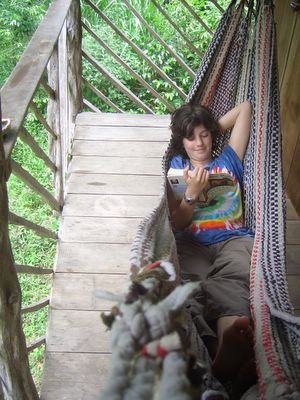Diane: The most remarkable thing about today is that it happened.
My last few attempts at putting together a multi-day family hike have been thwarted by schedules, weather, injured body-parts, bad attitudes, or some dastardly combination of the above. For example, I planned a 3-day backpacking trip in North Carolina last summer. Everything was perfect, until we got out of the car. Within 5 minutes, TM had hurt his leg so that he was limping badly. And before we could unload the car, it was pouring. It did let up for a few hours each day. Needless to say we did not go backpacking.
The last time we actually went backpacking, we hiked to a beautiful spot, set up camp, ate a bit. And then it started to rain. The prediction was for rain all night followed by sun the next morning. I thought that sounded okay. We'd just hang our tents and tent pads out to dry and then hike out. But, this was no ordinary rain. It rained so much that the river overflowed. In the middle of the night, we could hear the water rushing by our tents as everything inside got wetter and wetter. We woke up camped in the middle of a lake. I found Calliope's boots and socks floating nearby. The dry trail we had walked in on the day before was now covered in 1 - 3 feet of water. It was a spectacularly beautiful wade back to the car.
The rest of the family is now a bit reserved, when it comes to agreeing to go on an overnight hike with me. I get the silent treatment. Nobody refuses to go, but nobody actually talks about getting ready either.
So, when I found a tourism project offering a supported hike to take us from a town called Jima, 30 kilometers from Cuenca and high up in the Andes, down to the low-lying village of La Florida, nobody said much. A horse would carry all of our gear. We would have a guide. December and January are the driest times to hike in this region, so our timing was good. I exchanged emails with a couple of Peace Corps Volunteers that are helping get this tourism project off the ground. I forwarded everybody the information concerning the route, food and sleeping arrangements, difficulty level, guide, horses, etc. I then told everybody to incorporate more and more walking into their days in preparation for the trek. No response.
Today, the first day of the hike, Calliope and TM took turns riding a horse. Tom and I walked the whole way. The highest point we reached was at about 3000 meters, and we are spending the night at about 2200 meters. We followed a horse trail, since this is a roadless area. During the rainy season, each time a horse walks the trail, they compress the mud underneath during each step. Over time, large ruts form between tall humps of earth. Imagine a washboard dirt road with the washboard enlarged 10 times. When it rains, the ruts fill with water. We lucked out; it did not rain!
We hiked for 6 or 7 hours through spectacular scenery, moss-covered trees, and many tough looking plants. Linder, our guide, is a biologist. He showed us plant-related points of interest along the way, including the quina tree. This tree, which requires very specific growing conditions, was the sole source of quinine for many years at a time when it was the only treatment available for malaria. According to Raúl, our Spanish teacher at the Abraham Lincoln Center in Cuenca, the extension of the British Empire into malaria-infested countries was made possible by this tree.
Another plant of interest along the way is used by local women to make their hair grow longer. I figured if there were such a thing, I'd have certainly seen it (or some alternative) on drugstore shelves in the U.S. Linder is a trained biologist, but he didn't share my disbelief. Maybe we have a new find, ready for marketing back home.
We are spending the night in the schoolhouse in the small town of San Miguel de Cuyes. We had the additional options of staying with a local family or camping, but we are all too tired to evaluate such complexities.
The first resident we met said that 22 people live in this town. Linder says that as little as a few years ago, there were several hundred. There were a few young men hanging out by the schoolhouse, but I was too exhausted to try to carry on a conversation in Spanish.
We made it to our first destination in good weather and in good health. Nobody is blaming me for any misadventures. It has been a remarkable day.



















































